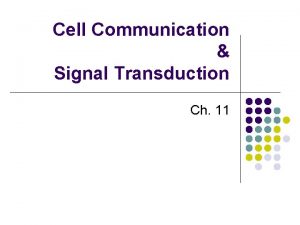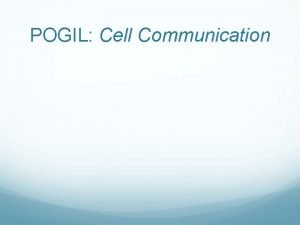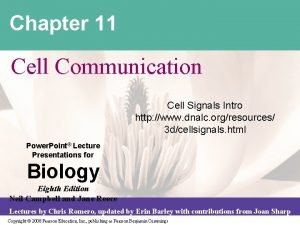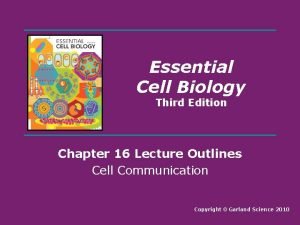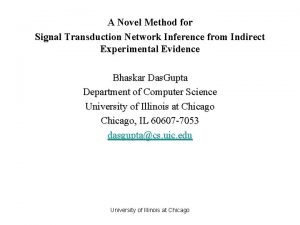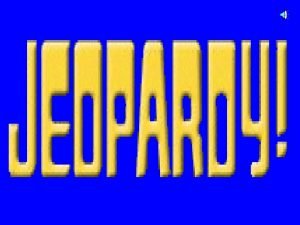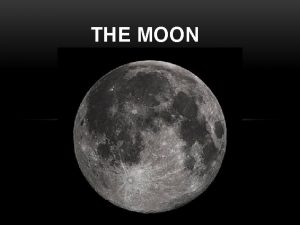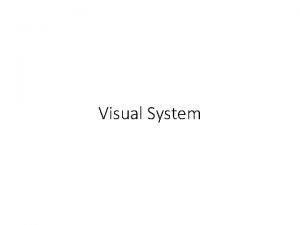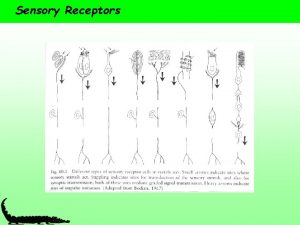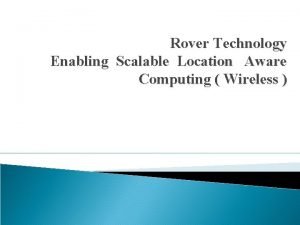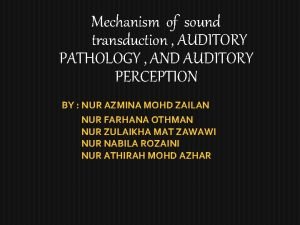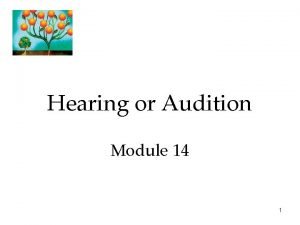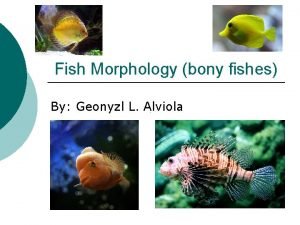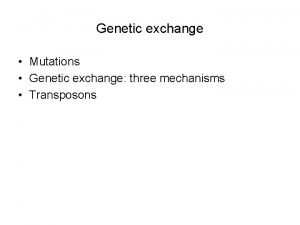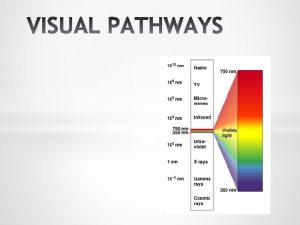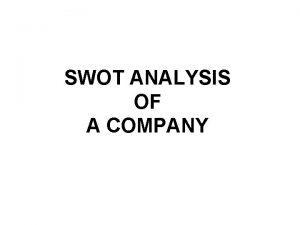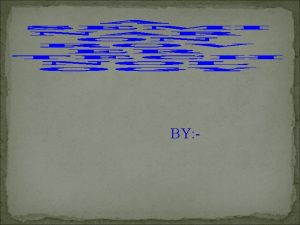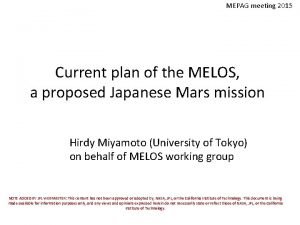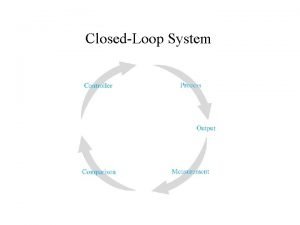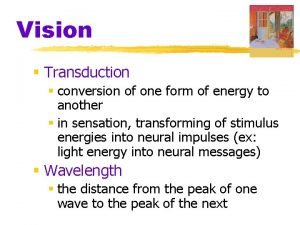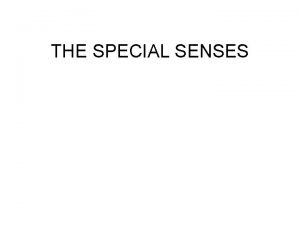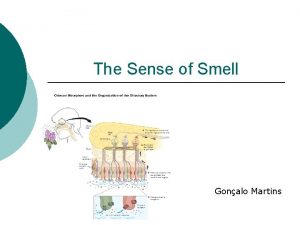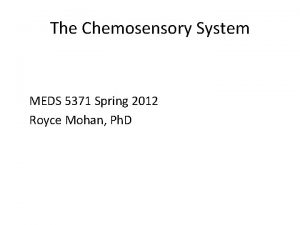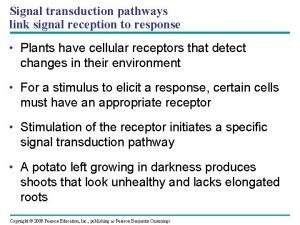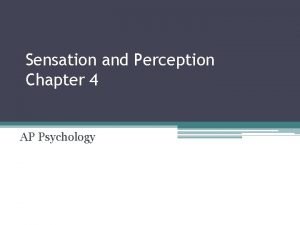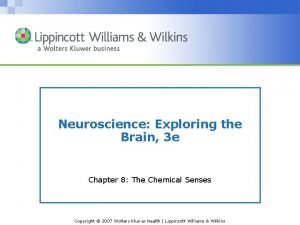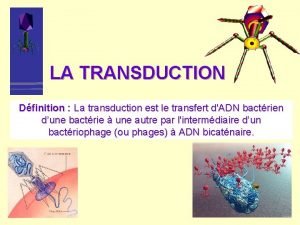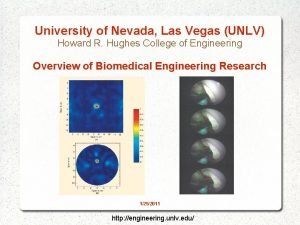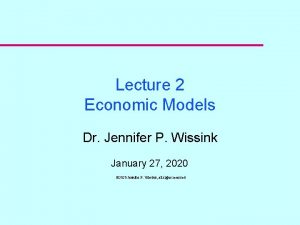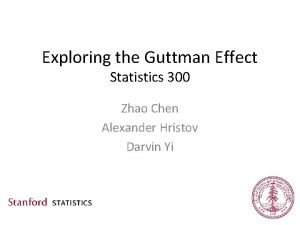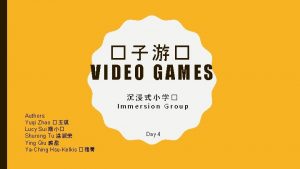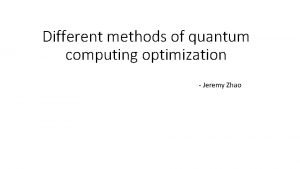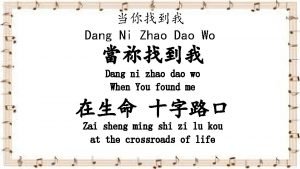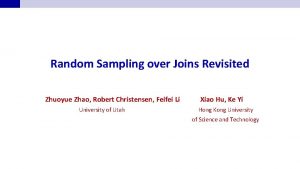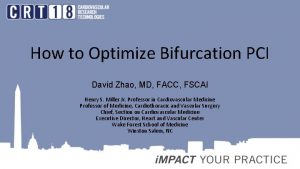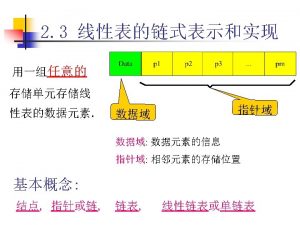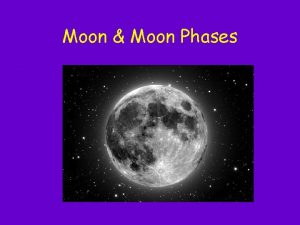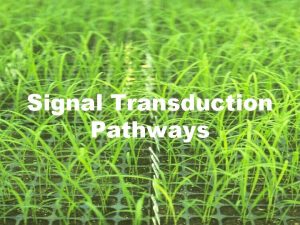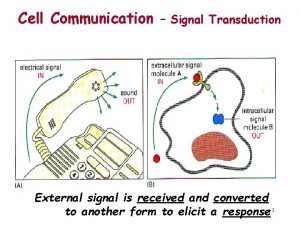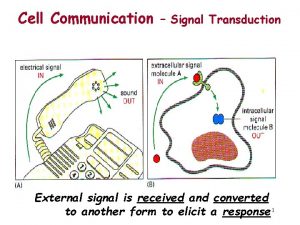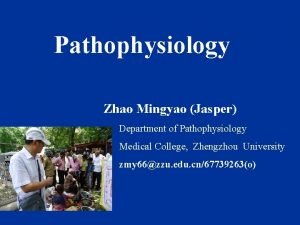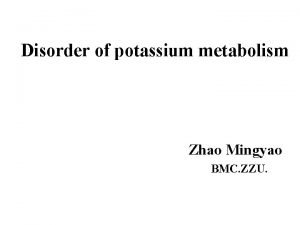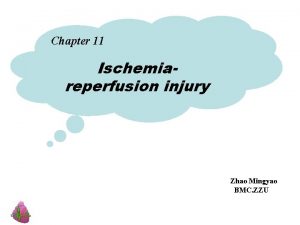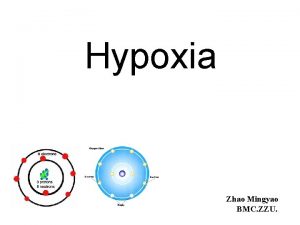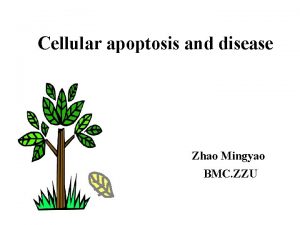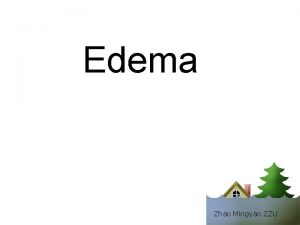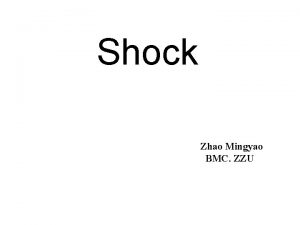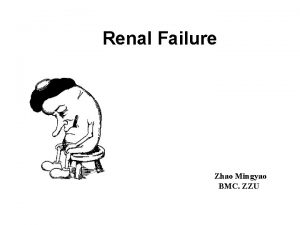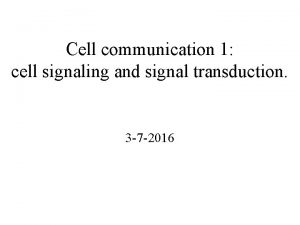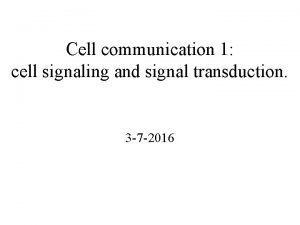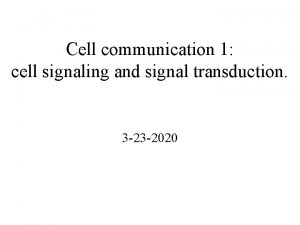Cell signal transduction diseases moon rover Zhao Mingyao
























































- Slides: 56

Cell signal transduction & diseases moon rover Zhao Mingyao BMC. ZZU

cell signal transduction signal cell specific response Proliferation Differentiation Metabolism Function Stress Apoptosis or loss disease



1. Signal constitution site feature (1)Extracellu Chemical: lipid-soluble & water-soluble lar ~ Physical: mechanical, light, electrical (2)Intracellul Enzyme, protein, ion, lipid ar ~

(3)Second messenger c. AMP, c. GMP Ca 2+ DAG(1, 2 -diacylglycerol) NO, CO, ? ceramide, phosphocholine allosteric agent

(4) Enzyme components ①Phospholipase(PL) : PLA 2, C, D, SMase (sphingomyelinase) ②Phosphatidylinositol kinase: PI-3 K, PI-4 K, PI-5 K / PTEN ③GP (Tripolymer & Small ) : GP(G ) = GTPase ④Protein kinase & phosphatase: PSTK & TPK or PTK ⑤AC, GC/ cyclic nucleotide phosphodiesterase: phosphatase and tensin homolog deleted on chromosome ten (PTEN)

(5) Receptor and its function 1. ionotropic ~: + neurotransmitter , ion 2. GPCR: metabolism , function modulation 3. ~ TPK: +insulin, GH 4. TPK-linking ~ : cytokine, antigen, some CAM 5. PSTK ~ : TGF-β 6. TNF ~ : apoptosis, NF-k. B 7. Guanylyl Cyclase ~: vasodilation, excreting Na+ urine 8. CAM : communication between cells 9. Nuclear ~: transcription regulatory factor

2. Signal transduction pathway channel Effect protein Transporter PL C E E ? GTP GDP Neucler receptor DNA

Major pathway of cellular signal transduction GP~ TPK~ GC (guanylyl cyclase)~ Nuclear ~

(1) Signal transduction pathway introduced by GP receptor GP DG-PKC PLC β AC IP 3、Ca 2+-Ca. K

β-R α 2 -R,M-R α 1 -R,ET-R Cori, 1947 Gsα Gi Gqα ? AC PLC β + Gilman 1994 c. AMP PIP 2 IP 3 c. GMP? Sutherland 1971 PKA DAG(DG) Murad 1998 gene Pro* Krebs 1992 Edmond H. Fischer PKC glycogenolysis GPCR signal pathway

Mechanism of GP GTP GP(G ) = GTPase GDP off on GEF + GAP - Small GP (G ) guanine-nucleotide exchange factor GTPase activating protein


signal transduction pathway introduced by GP -R β-R α 2 -R,M-R α 1 -R,ET-R Gi Gsα + - AC c. AMP PKA Target Pro phospho Gqα + + PLCβ PIP 2 IP 3 DAG(DG) Ca 2+ released Targetgene transcription PKC Target Pro phospho

Cholera toxin, CTX Cl-、H 2 O GTP CTX leads to Gsαarg 201 ADPribosylation c. AMP GDP AC ATP

Pertussis toxin, PTX Giα PTX leads to Giα ADPribosylation, blocks its activation AC + PLCβ

(2) signal transduction pathway introduced by TPK • Receptor tyrosine protein kinase, RTK (20 types) • PTK-linking receptor

1)Receptor tyrosine protein kinase, RTK (20 types) TPK Ras-MAPK PLC -PIP 2 PI 3 K Proliferation differentiation

GF >50 kinds TPK PI 3 K Grb 2 Sos PKB Target pro phosphorylation MEK ERK PLC PIP 2 Ras DAG Raf PKC IP 3 Ca 2+ Transcriptional factor phosphorylation DNA

Receptor Tyrosine Kinases

2)PTK-linking receptor IL、IFN、erythropoietin(most cytokine) JAK FAK PTK in Src family PTK phosphorylation STAT inducing transcription regulating express gene DNA response element cellular phenotype change JAK-STAT Pathway

(3) Signal transduction pathway introduced by GC

Furchgott

cytokines Furchgott found CO Ca 2+ Ach-R GTP NO synthase arg R GC s. GC c. GMP PKG NO Vascular dilation ? VEC NO VSMC Vascular GC signal transduction system


(4) Signal transduction pathway introduced by nuclear receptor GC, Mineralo~, gonadal H; Steroid hormon-R in cytoplasma except estrogen R; bind to HSP T 3, Vit D, Tretinoin; Thyroxine hormon-R Dimer; in ? bind to pro or DNA ? -R as ligand-dependent transcription factor

Crosstalk one or more components of one signal transduction pathway affect another

3. Pathophysiology of CST Etiology and pathogenesis (1) Structure and expression change of gene (2) Abnormal function of immune (3) Secondary abnormality

(1) Structure and expression change of gene signal pro ( p 53 ) amount : ↓or↑ function : ↓ or↑ structure(mutation) : domain; deactivated; continually activated; dominant negative effect GF-GFR: acromegaly and gigantism

Hormone resistance syndrome A disease caused by target cell reducing or losing its response to the hormone, but the hormone synthesis and secretion in normal level Nephrogenic diabetes insipidus

Constitutive activation Receptor hyperactivation out of control due to gene mutation, also known as the receptor gaining functional mutation

(2) Abnormal function of immune Self-antibody against Signal Pro

v Stimulating Ab to the receptor for thyroid-stimulating hormone (TSH) Hyperthyroidism, proptosis (protrusion of the eyes globes), Graves’ disease v Blocking Ab to the TSHR v Hypothyroidism, myxedema Hashimoto’s thyroiditis

(3) Secondary abnormality • Blood p. H • Ion concentration ·Pulling on single molecules : Nature. . . • ATP

Receptor up-regulation or down-regulation Receptor hypersensitivity or desensitization

4. Abnormal signal transduction and disease One or multiple pathways One or multiple steps

(1) Insulin-resistant diabetes (type II) abnormal receptor, deficiency behind receptor Glucose -carry PTK insulin Glycogen thynthase Cellular proliferation


(2)Malignant tumor Biological features • hyperproliferation • hypodifferentiation • hypoapoptosis • metastasis

Cellular canceration • Proto-oncogene: over-expression, mutation • Tumor depressor gene: mutation, loss, lowexpression • DNA repair gene: mutation, loss, incorrect repair (polβ)

Cellular canceration total features multifactors , multisteps, multigenes Colon cancer as a model

From normal cell to cancer cell


Tumor suppress gene negative signal : keep cell in G 1 phase following specific program to differentiate to be senile to be apoptosis

(3) Autoimmune receptor disease 1) Ab against receptor: structure change ; same antigen 2) Ab against specificity: • Stimulating Ab + TSHR --- Graves disease • Blocking Ab + TSHR --- Hashimoto disease • Blocking Ab + n. Ach. R --- Myasthenia gravis chronic thyroiditis


(4) Inflammation • More cells, factors , complicated net LPS-R TNF-R IL-1 R


TNFa R sphingomyelinase SM SMase PK ceramide + NF- B P 65 P 50 Gene transcription NF- B I B Cytokine, IM I B

Immune in stress β 2 -adr-R β-arrestin 2 inhibit Activation of NF- B

(5) Cardiovascular disease Myocardial Remodeling Myocardial hypertrophy

Ang-II Mechanic stimuli R-TPK integrin Pro * nucleus Gene transcription Mechanism of VSMC or myocardial Hypertrophy

BODYBUILDING Mechanic pressure stimulation

5. Principles for Treatment ①To regulate ligands ②To regulate receptors ③To regulate intracellular messenger and transducers ④To regulate nuclear transcription factors

( end )
 Cell signal transduction
Cell signal transduction Cellular communication pogil
Cellular communication pogil 3 stages of cell communication
3 stages of cell communication Essential cell biology chapter 3 quiz
Essential cell biology chapter 3 quiz Signal transduction
Signal transduction Signal transduction
Signal transduction Which moon phase occurs directly before a new moon
Which moon phase occurs directly before a new moon Which moon phase occurs directly before a new moon
Which moon phase occurs directly before a new moon Moon sister moon calendar
Moon sister moon calendar Home.hiwaay.net/ krcool/astro/moon/moon tides/
Home.hiwaay.net/ krcool/astro/moon/moon tides/ How many days for a moon cycle
How many days for a moon cycle Striate cortex
Striate cortex Baroreceptors chemoreceptors mechanoreceptors
Baroreceptors chemoreceptors mechanoreceptors Location aware computing
Location aware computing Transduction in the ear
Transduction in the ear Where does transduction occur in the ear
Where does transduction occur in the ear Dv-2400 video rover
Dv-2400 video rover Pitch in waves
Pitch in waves Sagittiform body shape
Sagittiform body shape Rover predator fish
Rover predator fish Generalized transduction
Generalized transduction Cajal bodies
Cajal bodies Tata swot
Tata swot Dad mom sister brother rover division
Dad mom sister brother rover division Comedy of manners
Comedy of manners Transduction psychology
Transduction psychology Rover technology
Rover technology Hahna alexander
Hahna alexander Melos
Melos Rover ruckus game elements
Rover ruckus game elements Cadillac escalade rental houston
Cadillac escalade rental houston Sojourner mars rover
Sojourner mars rover Transduction psychology
Transduction psychology Olfactory transduction
Olfactory transduction Olfactory transduction
Olfactory transduction Olfactory transduction
Olfactory transduction What are phytochromes
What are phytochromes Do subliminals work
Do subliminals work Olfactory transduction
Olfactory transduction Transductant
Transductant Rover.io
Rover.io Baseband signal and bandpass signal
Baseband signal and bandpass signal Baseband signal and bandpass signal
Baseband signal and bandpass signal Digital signal as a composite analog signal
Digital signal as a composite analog signal Even part of signal
Even part of signal Unlv biomedical engineering
Unlv biomedical engineering Jennifer wissink cornell
Jennifer wissink cornell Guttman effect
Guttman effect Zhao chun
Zhao chun Zhao yuqi
Zhao yuqi Irene zhao dao
Irene zhao dao Jeremy zhao
Jeremy zhao Ni zhao
Ni zhao David zhao md
David zhao md Random sampling over joins revisited
Random sampling over joins revisited David zhao md
David zhao md Zhao qian malaysia
Zhao qian malaysia
